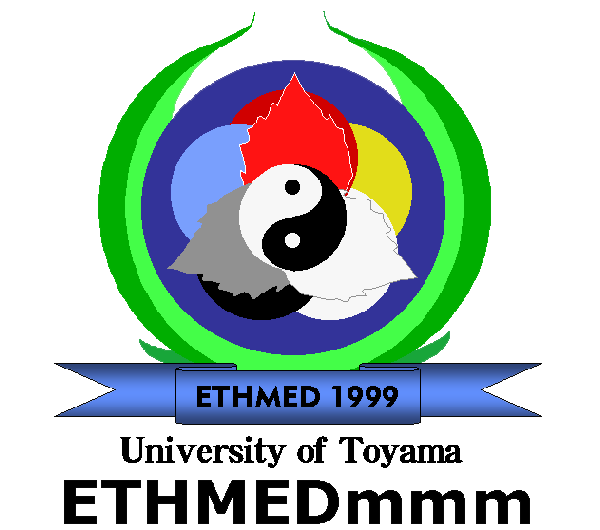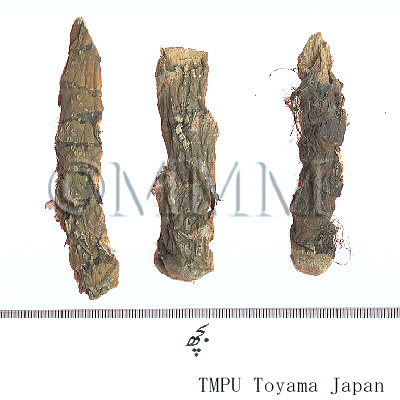Crude drug sample data base
※Click on the image to enlarge it.
The capital city, provincial capital city or the representative
location of its administrative area is indicated.
location of its administrative area is indicated.
Production area information
https://ethmed.toyama-wakan.net/img/pin_san.png
25.0700428
67.2847875
Collection information
Islamic Republic of Pakistan,Karachi [Karachi], Sind
https://ethmed.toyama-wakan.net/img/pin_nyu.png
Scientific information data base
| Crude drug name | Urudu name, English name | Bach, Sweet Flag Root, Calamus | |||
|---|---|---|---|---|---|
| Arabic name / Persian name | Ood al-wa / Agar-Turki | ||||
| crude drug image |
| ||||
| Original plant name | Acorus calamus Linn. | ||||
| Family name | Araceae | ||||
| Used part | Rhizome | ||||
| Distribution area | A marshy, aromatic herb; native to eastern N. America and temperate Asia. Commonly found in Kashmir, Manipur, Mysore, growing chiefly in marshy and moist situations of northeastern Himalayas. | ||||
| Description | Waj is the root of a plant resembling papyrus. It is mostly found growing near tanks and ponds. These roots are branched, bear white knots and have unpleasant odour along with some fragrance. The taste is sharp and pungent. According to Galen, only the root is used as a drug. Dioscorides says its leaves are similar to those of orris plant. The roots of sweet scented flag are not very dissimilar to those of orris. They are not straight but crooked in shape. The upper surface of roots bear some knots of white colour. There are two types of drugs. (1) Qinnisirin (a town in Syria) and (2) Arghalatia (another kind of sweet scented flag). The latter is procured from Spain. The kind which is thicker, more compact and fragrant is considered good. Discorides, however, believed the thick, white, compact, uncorroded variety without flaccidity and having fragrant odour to be of best quality. | ||||
| Function and properties | Cosmetics, Joints, Head, Eye, Chest, Vital organs, Excretion. It is carminative, attenuant, detergent, without being irritant, deobstruent, diuretic and antiflatulent. It is also antiphlegmatic. It purifies the brain and sensory nerves. | ||||
| Specific actions | Antiphlegmatic and aromatic stimulant. | ||||
| Frequency in use | Common. | ||||
| Common uses | Its use proves useful in forgetfulness, palsy, paralysis, stammering, insanity, epilepsy and dementia. Cosmetics: It improves the complexion and proves useful in pityriasis and leucoderma. Joints: It is useful in convulsions and rupture of muscles. Head: It is also useful in cases of odontalgia and heaviness of the tongue. Eye: It is useful for treating corneal thickness and opacity. Its extract is particularly useful for removing dark-sightedness. Chest: Its decoction is good for pleurisy and chest pain. Vital organs: It is advised in cold hepatalgia and also strengthens the liver. It is useful in stomach diseases and splenic hardness. It reduces the size of spleen and depurates the stomach. Excretion: It is useful in gripes and hernia. Its decoction gives relief in uteralgia and acts as a diuretic and an emmenagogue. According to some physicians it is also useful in strangury. It acts as a stimulant and increases libido. It is useful in intestinal pain and abrasions caused by cold. | ||||
| Side effect | It is useful in insect bite. It serves as a good insect repellent. In large doses it may produce violent and persistent emesis. | ||||
| Medical system | Unani | ||||
| Traditional concept | Temperament | It is hot and dry in the second degree. | |||
| Drug effect | It purifies the brain and is very beneficial in the disorders of the brain. It is harmful for those people who possess hot temperament. | ||||
| Dosage | 1 to 2 gm. | ||||
| Substitute | Zirah Safaid (Cuminum cyminum Linn.) and Himalayan rhubarb act as substitute for these effects: expelling gases and being useful in liver and splenic diseases. | ||||
| Related drugs | The commercial material, especially that procured from Northeastern regions is adulterated with the rhizomes of Costus speciosus (Koen) Sims. (Fam. Zingiberaceae) which are odourless and brownish in colour. | ||||
| Corrigent (corrective) | Badiyan (Pimpinella anisum Linn.), anise and Sikanjebeen Sadah (lemon juice mixed with table sugar in water). | ||||
| Important compound preparations | Ma`un Talkh and Ma`jun Muqil. | ||||
| References | Reference book Tips! | Illustrated Manual of Herbal Drugs Used in Ayurveda, 1996. Sarin, Y.K., Council of Scientific & Industrial Research and Indian Council of Medical Research, New Delhi p 110. Makhzanul-Mufradat (Khawasul Adviyah), Hakeem Kabiruddin, Daftar Al-Masih, Qarol Bagh, Delhi. pp 121-122. A Survey of Drugs, 1961 (2nd edi.). Wahid, A. K. and Siddiqui, H. H. Institute of History of Medicine and Medical Research, Delhi. pp 37, 78, 110. Dictionary of Economic Plants in India, 1996 (2nd Rep.). Singh, U; Wadhwani, A. M. and Johri B.M. Indian council of Agricultural Research, New Delhi. p 6. Al-Qanun Fil-Tibb. Avicenna. (English translation of the critical Arabic text), Book 2, 1998. Hameed, H. A. (editor), Dept. of Islamic Studies, Jamia Hamdard (Hamdard University), New Delhi. pp 459-460. Hamdard Pharmcopoeia of Eastern medicine, 1969. Said, H. M. (editor), The Times Press, Sadar Karachi. pp 263, 286. Indusyunic Medicine, 1997. Usmanghani, K., Saeed, A. and Alam, M. T. Department of Pharmacognosy, Faculty of Pharmacy, University of Karachi, Karachi. pp 87-89. | |||
| Remarks | Avicenna (Ibn Sina) has described this drug under the head ''Waj''. An essential oil, obtained from rhizomes, is used in perfumery and for flavouring liquors and other food stuffs | ||||
| Last renewal date | 2024/02/22 | ||||




